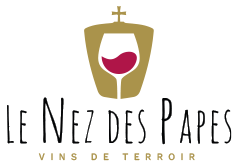The vines benefit from a set of climatic conditions that are very favorable.
In the northern part of the valley, there is a moderate continental climate with hot and sunny summers. The autumns are cooler and the winters harsher than in the southern part. In the southern part of the Rhone Valley the climate is Mediterranean with dry and hot summers. The winters are mild with plenty of Mistral wind (a great asset for the vineyard because the wind helps to keep away diseases).
As for the climate, there are important differences in the topography and soils from north to south.
In the north, the hillsides are very steep, while in the south there are small hills with gentle relief and vast flat areas. The main soils of the Northern Rhône Valley are clay, stone or granitic and offer colorful, powerful wines with beautiful aromatic finesse. In the South, the wine growers cultivate on clay, stone , limestone or sandy soils (limestone and sand bring lightness and subtlety to the wines). Diverse in soil and rich in ancestral know-how, the Rhône Valley has a lot to offer to wine lovers.
We can discover wines of different styles: varieties in the north consisting predominantly of marsanne, roussanne and viognier (for the white wines) as well as Syrah (the queen of the north) for the red wines. In the south, winegrowers blend more varieties and terroirs. The most used red grape varieties are Grenache, Mourvèdre and Syrah. The white blends are mostly made with white Grenache, Roussanne, Clairette and Marsanne. Most of the wine produced is red (76%) but there are also excellent rosé wines (14% of the total wine production) and white wines (10%). These vineyards represent:
- More than 5,000 vineyards producing AOC wines
- 2.6 million hectoliters harvested per year (33% of the production is exported)
- 31 AOCs, some of which are world famous
- 17 village crus (Côte - Rôtie, Condrieu, Château Grillet, St Joseph, Crozes - Hermitage, Hermitage, Cornas, St Peray, Vinsobres, Cairanne, Rasteau, Gigondas, Beaumes de Venise, Vacqueyras, Châteauneuf du Pape, Tavel, Lirac)
- 34 grape varieties
- 6000 hectares of certified biodynamic, organic or in conversion



























